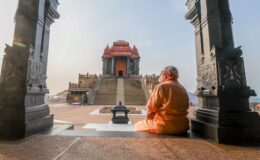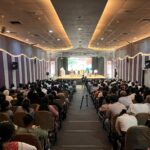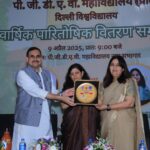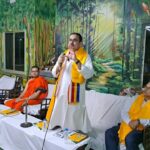So intricately designed is the miasma of deception or so complete has been the control of the system by the intellectual cheerleaders of those who carried out the Emergency, that its history was hardly ever taught. It is essential to introduce a study on the Emergency
June 25 to June 26 announces the 40th year of one of the darkest episodes in the history of independent India. These were days on which was carried out a murderous assault on India’s soul that had found utterance after long suppression on the midnight of August 15, 1947. The declaration of Emergency on the midnight of June 25 was a brazen attempt to suppress that soul of free India, a maniacal assault on its civilisational being. It announced the darkest phase in free India’s experiment with democracy, a phase where nothing was sacred, where the sacred was profaned and the sublime ridiculed and crushed under the weight of an overweening power of intolerance, of hatred and of irreverence for the power of human goodness and of human liberty. Never since its independence had India witnessed such darkness enveloping her present and threatening her civilisational identity.
Yet, so intricately designed is the miasma of deception or so complete has been the control of the system by the intellectual cheerleaders of those who carried out this near fatal assault on the Indian psyche that its history was hardly ever taught, nor discussions on it ever encouraged. A true and essential history of that phase when a democratically elected Government in India chose to suppress its own people and to hammer down dissent, has never been written or narrated — a powerful and motivated section, sometime participants and proponents of that terrorising clampdown have ensured that a shroud of silence and amnesia hover around and cover that episode so that generations to come may someday disbelief that India had one day passed through such an agony.
It is essential, therefore, to seriously consider the need to introduce the study of the Emergency and assault on Indian democracy and the Constitution as a course not only in universities across the country but also at early levels when a defence of democracy can be erected in young minds. The Indian Council of Historical Research may also consider initiating a multi-volume project on recording, documenting and narrating the history of the Emergency so that the story of those dark days are forever recorded and preserved for posterity.
Those who readily disseminate sermons on the need to protect free speech and resist the rise of a “fascist” “corporate-communal alliance” were either at the forefront of justifying the imposition of the Emergency dictatorship or were absent during the massive and countrywide struggle for restoration of democracy launched by the workers of the Rashtriya Swayamsevak Sangh and the Jana Sangh, many of whom never came out alive from detention or when they did, were crippled and maimed for life.
Suffering from the dilemma of whether to see the Emergency as the manifestations of imperialism or the advent of a dictatorship of the proletariat, these self-styled messiahs of the ordinary and oppressed people of India, conveniently avoided the jails and hell-holes of the Indira Gandhi regime. Some of the most articulate comrades, great and profound dialecticians, had themselves come out in support of this phase.
The veteran comrade Shripad Amrit Dange advised Indira to clamp down on reactionaries, because “JP (Jayaprakash Narayan) represented forces at home and abroad who were determined not so much to oust her from power as to destroy our democratic system and our independent foreign policy.” Dange’s foot soldiers in Bihar, the ‘red shirts’ tried to subdue and crush the spontaneous students’ movement in favour of democracy by taking out huge demonstrations with red shirt — so similar to ‘brown shirt storm troopers’ — volunteers who were armed “not only with lathis but with
other weapons.”
Dange’s partymen in Parliament, also came out in Indira Gandhi’s favour, especially her attempt to fix the Constitution. Indrajit Gupta was all for “taking away the Supreme Court’s powers in many things” while his colleague and her close friend, Bhupesh Gupta, interestingly referring to himself “as a citizen of the country, as a democrat, as a champion of the working people of our country, as one who believes in going forward by smashing all the way the forces of reaction and counter-revolution” extended support to Indira Gandhi’s efforts to confer upon herself supreme regulative powers even beyond
the Constitution.
In fact, the one document, the Justice JC Shah Commission report, that had recorded, to a certain extent, the degree of bestiality unleashed on the people of India during those days and had unravelled the intrigue to subjugate them under a new variety of fascism was itself confiscated and consigned to the dungeons of oblivion preventing future India from evaluating and admiring the second struggle for freedom that Indians had undertaken to protect their destiny.
On August 15, 1975, a deeply disturbed Dada Dharmadhikari, veteran freedom-fighter and Gandhian, wrote to Acharya Vinoba Bhave — who had strangely argued that the Emergency period was a phase of national discipline — anusashana parva — that he was not sure “whether today is the 29th anniversary of our freedom or its first death anniversary…” Prabhakar Sharma, a dedicated Sarvodaya worker and erstwhile satyagrahi, in a letter to Indira Gandhi, described how shocked he was to see atrocities perpetrated by “a so-called Congress Government that was educated in non-violence under the leadership of Gandhiji”. Sharma, who eventually immolated himself in protest against Indira’s dictatorship, sacrificing his body at the “altar of your Maintenance of Internal Security Act”, saw her regime as a “body of goondas” which had “completely turned its back to humanity, character, justice, decency, honesty and Indian culture”. Hundred of such Gandhians and freedom fighters waged a second battle of freedom and at times succumbed in their fight to protect freedom in free India.
While Indira Gandhi’s partymen were busy settling scores, oppressing ordinary people by stuffing and torturing them in jails or forcefully sterilising them through an elaborate and official population reduction programme that was pushed through by the Congress toughs, who threatened Governments servants with non-payment of salaries and dismissal if they failed to meet targets — in fact in Bihar over 80 people died due to faulty sterilisation procedures — the RSS and the Jana Sangh workers in thousands courted arrest, faced torture and death in their struggle to restore democracy and preserve India’s integrity.
The RSS’s sacrificing spirit and zeal to protect India’s spirit of democracy so profoundly moved Shivaram Karanth, legendary littérateur-activist, that he did not hesitate to publicly observe that “…the main burden of the struggle (against Emergency) was borne by them (workers of the RSS), it is they who had kept up the people’s moral. More than 80 per cent of the cadres who struggled for democracy had been drawn from the RSS. I have personally seen thousands of their young men solely inspired by a spirit of idealism, without any desire or expectation in return, plunging into struggle. Often they had nothing to eat, no place to rest, but their zeal remained unabated.” Isn’t it ironical, that 40 years since that dark phase, those who imposed Emergency and those who directly or indirectly supported it, refer to those who resisted as “fascists” and “anti-democratic”? This June 25 to June 26, is an opportunity to, as JP said, tell people “of the meaning of civilised freedom, and that freedom and democracy are the foundations of civilised mankind”.

















